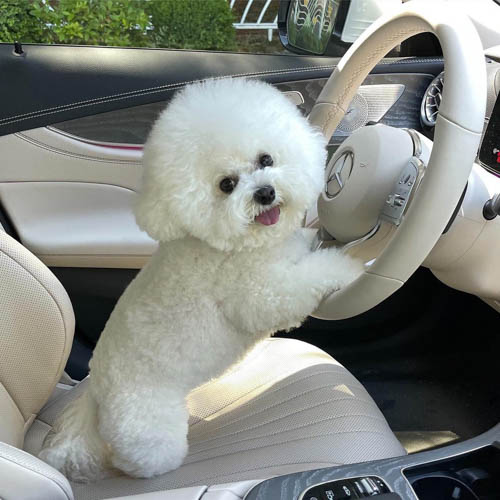Dogs are man’s best friend, and for the most part, they are very friendly and playful. However, deaf dogs have a different story to tell. When a dog loses its hearing ability, its behavior can change drastically.
Because of hearing loss, they are often scared and scared of loud noises. (Sound familiar?) Even though a deaf dog is very cute and adorable, training a deaf dog can be daunting.
If you are willing to put in the time and effort to train a deaf dog, they can be just as loving and fun as any other dog.
What Causes the Deafness of a Dog?

Let’s talk about the causes of deafness in dogs and the fact that they have a genetic link most of the time. However, this does not mean you should not adopt a deaf dog.
You should, as deaf dogs make excellent pets, and their lack of hearing does not have to be a burden for the family.
But how can you train a deaf dog? Does this mean they never learn how to do anything? Well, not exactly.
Deaf dogs can be trained, just like hearing dogs, but there are some special considerations. Like all dogs, there are various ways that you can train them. Read more to find out more.
Training Time!
Training a deaf dog requires a different approach than you would use with a hearing dog. Deaf dogs are not impaired; they can’t hear. Dogs learn by observing and endeavoring to please their humans.
They use their other senses to compensate for their lack of hearing, which means deaf dogs rely primarily on their sense of smell. Although a deaf dog may not hear your voice, he will still hear the tone of your voice and the vibrations of your footsteps.
With your help, your deaf dog can overcome their lack of hearing, and you can train your deaf dog easily. Here are the following ways on How to Train a Deaf Dog will be:
1. Get your dog’s attention.

If your dog is deaf, it can be even more challenging to get his attention. You may be tempted to shout or stomp your feet, but those methods don’t work very well.
Deaf dogs can have the same wonderful life as hearing dogs. Learning how to train a deaf dog can be a lot of fun for you and your dog! Many people who know how to train a deaf dog feel they have learned so much more about communication. Understanding how to train a deaf dog can make your and your dog’s life easier.
2. Teach the dog hand signs.
Deaf dogs cannot be trained to respond to verbal commands, but they respond well to hand signals. They react to the body language of their owners, and because the owner can’t use verbal cues, the dog has to learn to rely on the owner’s body language.
Dogs read your body language, so you can use hand signs to communicate with your dog. The way to train a deaf dog is to use hand signals and to be consistent in their use.
This dog training method is different from how most owners train their dogs, and the way to do it is to treat your deaf dog as if they are a child and speak their language.
When you want to get your deaf dog’s attention, use a hand signal and a verbal cue at the same time.
For example, you can use a hand signal to get the dog to look at you, then say “sit” while pointing to the ground and using a hand signal to get the dog to sit. This is the best way to make sure your dog understands the hand signal and verbal cue.
Training a deaf dog is often a little more challenging than training a dog that can hear. Most deaf dogs respond to hand signals and learn to understand hand sign language, but it’s important to make sure you learn how to use hand signals correctly first. To help you more, here are some basic tips for training a deaf dog:
3. Use a clicker.

Any dog can be trained to respond to a clicker as one way to train a deaf dog. The clicker is a small handheld device that makes a clicking sound when you press it.
You should start by teaching your dog to come to you before using the clicker to train him. He should also already know some basic commands, such as sit and down.
Teach the dog that the clicker means he is going to get a treat. Each time the dog does something you ask of him, click the clicker and hand him a treat.
After a few sessions, you should be able to dispense with the click and simply hand out the treat. The dog will come to associate the clicking sound with the treat. The clicker may be the best way to let your dog know you’re happy with him.
4. Use a vibrating collar.
The first step to training a deaf dog is to get started early. You are probably wondering how you can start training a deaf dog if it can’t hear anything you say. The answer is using a vibrating collar.
A vibrating collar is a collar that will vibrate when you pull the leash to get your dog’s attention. The vibrating collar will act as a cue to your dog that it has done something you don’t like and needs to change its behavior.
5. Keep them on leash.
As a deaf dog owner, you just have to re-invent the wheel to train your dog to do anything. You will have to train your dog on the same task multiple times, but this is only because your dog is deaf and will not be able to hear your first few requests.
This is why, when training your dog, you have to keep them on a leash, so you can physically get your dog to look at you as you ask them to do something. When your dog looks at you, you will sign to them or even use your voice if you know sign language.
6. Use a Flashlight.
Using a flashlight may be one of the ways on how to train a deaf dog. A deaf dog is a dog that is both blind and deaf.
This makes such dogs very dependent on their sense of smell and feel. They are likely to follow the hand of their owner if they are rubbing the dog. The owner has to use the flashlight to shine it on the floor.
7. Use positive reinforcement to train your deaf dog.

Training a deaf dog can be difficult since you cannot use verbal commands or a whistle to get the dog’s attention. You will need to rely on positive reinforcement and rewards to train the dog.
Reward her with treats and praise whenever she performs a command correctly. If she does not respond to the command, try gently tugging on the leash or patting her on the head to get her attention.
If you have ever owned a deaf dog, you know that training is a lot different from training a normal dog—the reason why is that you have to train your dog by hand signals and vocal commands.
If you get a puppy that is born deaf, you will need to wait till it is old enough to understand hand signals and vocal commands.
Also, you will need to remember that if the puppy is born deaf, it will not hear any noises, so you will need to make sure it knows when it is safe to bark and when it is not.
8. Training Mistakes
When training a deaf dog, it’s important to know that dogs are open to learning, even if it’s not to do something. This means if you train your deaf dog to do something, they will do it.
So, it’s imperative to make sure you train your deaf dog correctly. Some common mistakes owners make when training a deaf dog include:
• They don’t use hand signals when training.
• They don’t include the dog in the training process.
• They don’t take the time to train the dog.
• They don’t take the time to socialize the dog.
• They don’t take the time to train the dog to not bark.
• They don’t spend time with the dog to build that bond.
Now that you know the common mistakes, we can already expect you to train your dog well. And of course, if ever you will be training another deaf dog again, you will be avoiding committing any of these mistakes.
Important Reminders
Why do we need to train our deaf dogs? Dog training is about developing a response to a command that the dog cannot naturally perform.
For example, you might want your dog to sit when other dogs are around. You cannot expect the dog to do this without training. But once the dog understands the “sit” command, the dog will do it every time you give the command.
Training your dog to do a specific thing is an important part of being a good dog owner. While you will need to make some special accommodations for your pet, deaf dogs can live full and happy lives with the right training and care.
